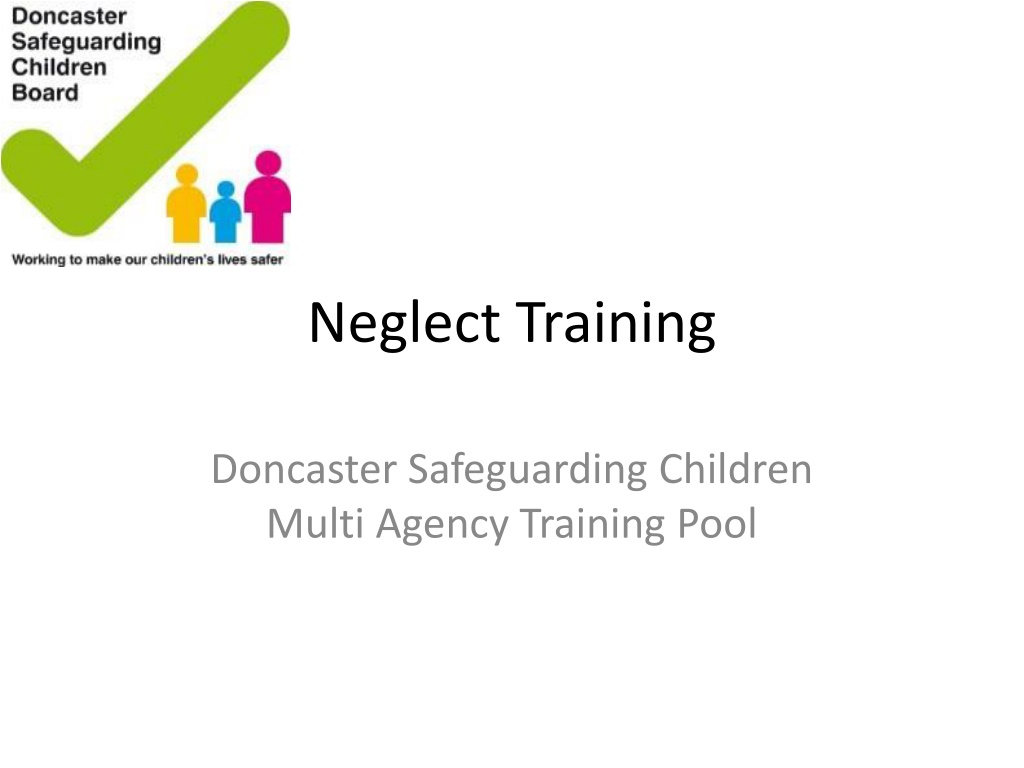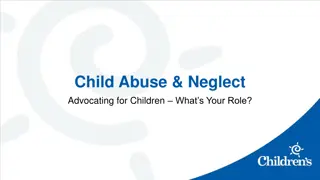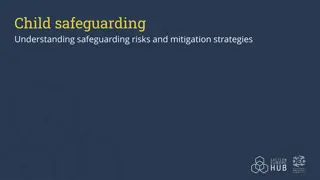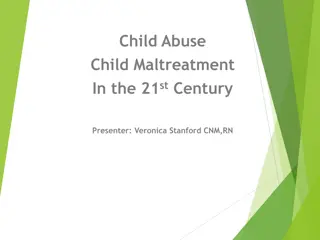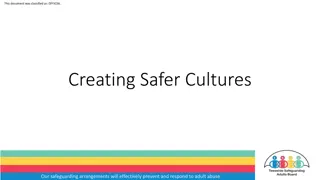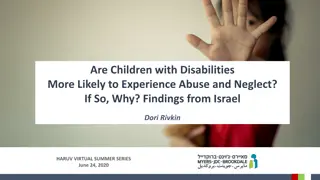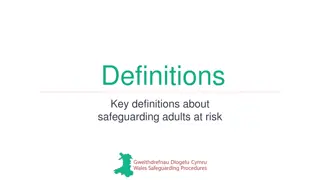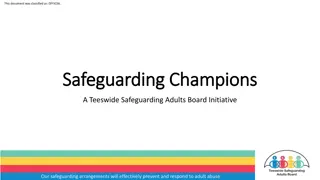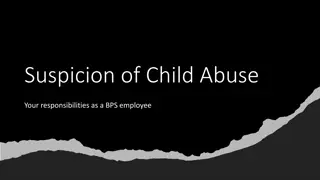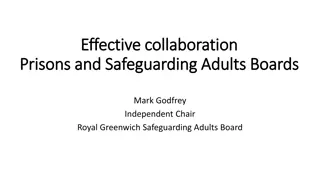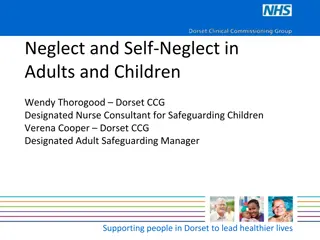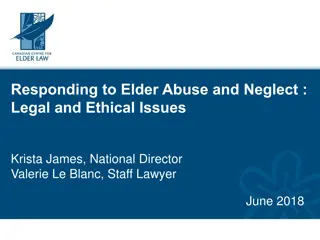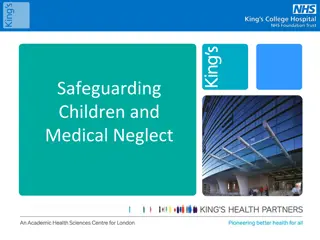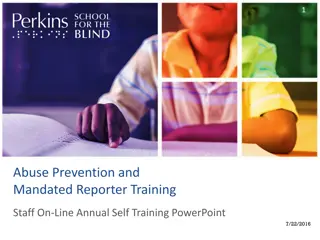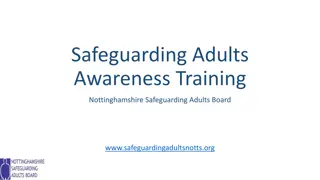Safeguarding Children Training on Neglect and Abuse
Explore the critical aspects of neglect in safeguarding children, including defining neglect, its impact on childhood development, identifying types of neglect, lessons from serious case reviews, and assessment and intervention strategies. Engage in discussions, establish ground rules, and understand statutory and civil definitions of neglect for effective safeguarding practices.
Download Presentation

Please find below an Image/Link to download the presentation.
The content on the website is provided AS IS for your information and personal use only. It may not be sold, licensed, or shared on other websites without obtaining consent from the author. Download presentation by click this link. If you encounter any issues during the download, it is possible that the publisher has removed the file from their server.
E N D
Presentation Transcript
Neglect Training Doncaster Safeguarding Children Multi Agency Training Pool
Objectives To consider: How we define neglect Impact on childhood development Identifying different types of neglect Learning Lessons from Kyra Ishaq Analysis of Serious Case Reviews How we assess and intervene
Ground Rules Please switch all mobile phones off there will be regular breaks throughout the day. Be prepared to contribute to the discussion. There are no wrong questions. Some of the information discussed may be upsetting. Only one person talking at once as it becomes difficult to hear/follow discussion. General housekeeping. Pre course evaluations.
Introductions. Spend a few minutes talking to the person next to you regarding their name, professional role etc. This will be followed by a round of introductions.
DSCB Business Plan and Strategic Priorities SP3 Doncaster has effective arrangements for responding to key safeguarding risks ( particularly child sexual exploitation, missing children and neglect) promoting early identification and support to prevent escalation of risks to keep children safe. 3.4. to ensure and embed effective arrangements to respond to early signs of neglect; including for unborn children. Draft neglect strategy written.
Defining Neglect In your groups discuss and write down a definition of neglect. Nominate one person to feedback.
Two statutory definitions of neglect A criminal offence under the Children Act 1933 defined as failure "to provide adequate food, clothing, medical aid or lodging for [a child], or failed to take steps to procure it to be provided focus on physical neglect rather than emotional or psychological maltreatment
The civil definition of neglect Children Act 1989 Persistent failure to meet a child's basic physical and/or psychological needs, likely to result in serious impairment of the child's health/development. Neglect may occur during pregnancy e.g maternal substance abuse. May involve failing to provide adequate food, clothing and shelter (including abandonment); Failure to protect a child from physical and emotional harm or danger; ensure adequate supervision (including the use of inadequate care-givers); Or ensure access to appropriate medical care or treatment. It may also include neglect of, or unresponsiveness to, a child's basic emotional needs.
Children subject to CP Plans- Doncaster Breakdown of categories as at 18/10/2015: 214 children are subject to CP Plans under the category of Neglect 98 children are subject to CP Plans under the category of Emotional Abuse 30 children are subject to CP Plans under the category of Physical Abuse 14 children are subject to CP Plans under the category of Sexual Abuse Total 356
Difficulties with the Definition Refers to basic physical/ psychological needs without offering clarity of basic . Suggests impairment should be serious - creates uncertainty as to the level of neglect required to trigger a referral. Expressed in terms of the behaviour of the child s caregivers what they are failing do says little about the impact on the child. Definition should be child-focused what the experience of neglect means for the specific child. Like other forms of child maltreatment, neglect needs to be interpreted in context ( Community Care Inform, 2015)
Horwaths Definition Failure to complete parenting tasks required to ensure developmental needs of the child are met. Should take into account the age, gender, culture, religious beliefs ..of the individual child. Failure may be associated with parenting issues. It has occurred despite reasonable resources being available Whilst neglect is likely to be ongoing, one-off incidents and episodic neglect can affect the health and development of a child. (Horwath, 2007, p38)
Empathy "at the heart of neglect [...] is a lack or loss of empathy between the parent and child". NSPCC
DSCB Procedures- Single Assessment What are the developmental needs of the child? Are the parents able to respond appropriately to the child s developmental needs? Is the child being adequately safeguarded from significant harm? Are the parents able to promote the child s health and development? Assessments should be rooted in child development Framework for the Assessment of Children in Need 2000.
The Science of Early Childhood Development Center on the Developing Child at Harvard University (developingchild.harvard.edu) Addresses basic concepts of early childhood development helping to illustrate why child development particularly from birth to five years is so important. The Science of Child Development
Key Points re Early Childhood Development Biologically the brain is shaped by experience. The importance of the serve and return interaction. When children experience neglect this leads to a wear and tear effect. Intervening early is important. Neglect impairs the ability to learn as the cognitive and emotional functions of the brain cannot be separated. The Science of Neglect
The Science of Neglect- Key Points Children need to have responsive interactions with adults. Neglect can cause a child to be constantly bathed in stress hormones Interventions need to attune people to the serve and return process. Harvard provide us with four levels of neglect.
The four Harvard Levels of Neglect Occasional inattention - not concerning, may potentially benefit a child s development. Chronic under stimulation- Impacts on development but children will show catch up with the right intervention. Severe neglect in a family context- not being fed/bathed etc., puts a child more at risk of substantial deficits. Severe neglect in institutional settings alters the development of the brain architecture, constant change of care givers.
Child death reviews: Statistical First Release : Year ending 31 March 2015 60 children died as a result of deliberately inflicted injury, abuse or neglect. 32 had modifiable factors. 90 children died as a result of suicide or self harm (40 modifiable) 182 died as a result of trauma (104 modifiable) 321 died as a result of sudden unexpected unexplained death (177 modifiable) 74 Road Traffic Accidents (37 modifiable) 30 drowning (20 modifiable)
Ward and Brown Severely suboptimal and abusive parenting during the first 3 years of life has a disproportionately large impact on the infant/toddler brain. Helps us to understand the extensive evidence about emotional and behavioural development of very young children. For example, the persistent fear response, hyper- arousal, dissociation and disorganised attachments that have been widely identified Harriet Ward Decision Making within a Child s Timeframe- You Tube.
Counter argument Wastell and White Without details of case history for the neglected child, such an image is meaningless; perhaps the child was the subject of trauma, or disability. We simply do not know. Mythological version of the infant brain is fast becoming part of the policy and practice. Easily invoked to profound rhetorical and material effect. Debate regarding how well the brain can recover from neglect- e.g. Romanian orphans.
Group Activities In your groups think about think the day to day experiences for these children and record the following: 1. What is the evidence for how well each child s needs are being met in the six areas described ? Physical Emotional Supervisory Medical Educational Socialisation
Mark and Sarah Mark is seven. He lives with his parents and sister in a flat with no carpets and curtains. His bedroom is full of bin bags of rubbish, and his clothes are left mixed in with more rubbish on the floor. He sleeps on a stained mattress with an old blanket. The family s flat is cold and in a poor state of repair. Mark s parents keep their dogs inside and there is both dried and fresh excrement on the living room floor, walls and sofa. Mark s sister is Sarah. She is three years old. Sarah and her brother haven t received any childhood immunisations and they both regularly experience colds and gastroenteritis due to their living conditions. Sarah s father has limited involvement in his daughter s day-to-day care. Her mother doesn t like the nursery, so she doesn t take her there. Instead, Sarah spends long periods in a baby walker that has had its wheels removed. Mark attends school irregularly and his parents do little to encourage him to participate more. Mark and Sarah s parents are struggling with addictions to drugs and alcohol, and find their children s demands for attention and cuddles difficult to cope with. Sometimes they get angry with the children because they are not able to look after themselves.
Mark If the physical environment for Mark does not change, he will continue to have chronic health difficulties such as tummy upsets, which means that his school attendance will fall even further, impacting on his learning and friendships. He will be at home more often and looking to his parents for attention, with the result that his parents consider that he is making too many demands upon them. This is likely to cause Mark s parents to become resentful.
Sarah Sarah s lack of physical stimulation may impair her development of balance and motor skills. The lack of emotional warmth in the family may cause her to become withdrawn and passive, or to crave physical contact even from adults she does not know. Frequently having colds and tummy aches is likely to make her seek even more cuddles and attention, which her parents may perceive as her being demanding and clingy .
Aisha Nine-year-old Aisha has spina bifida. Spina bifida is a fault in the development of the spine. For Aisha, this means that she is partially paralysed, leading to weakness in her leg muscles. She has crutches and ankle supports to help her mobility. Aisha s grandmother, who looks after her, does not believe Aisha needs special treatment. She thinks too much of a fuss is made about it all. She doesn t take Aisha for her regular hospital appointments or physiotherapy sessions, and does not implement the plan of physical exercise recommended She also does not believe it is necessary to use the special equipment provided, and has put it all in the shed.
Aisha The issue of medical neglect may be uppermost in people s minds in this case, but the care Aisha is receiving is also likely to have an impact on her emotional wellbeing. She may feel depressed and start to believe she doesn t deserve care. She may believe she is a burden on her grandmother. Her inability to access school and leisure activities will affect her educational achievement. It will also isolate her and affect her emotionally.
For other children, their needs are intentionally not met. This might mean that children are scapegoated, or held responsible for their lack of care. For example Mark and Sarah s parents said that they did not take their children to the doctors because they did not deserve it, because they made too many demands on them. For other parents, they themselves have such high levels of need that they find it extremely difficult to put the needs of their child first. The most importantissue is whether a child s needs are being met not whether neglect is intentional. However, a good understanding of the reasons underlying neglect supports meaning for the child effective intervention.
Forms of Neglect Supervisory: Children- not protected from danger and harm. Younger children-Greater risk of accidents. Older - failure to protect from risky behaviours such as substance misuse. Medical Neglect: May include failing to seek treatment for emergency or acute illness. Failure to provide care and treatment for chronic illnesses or disabilities. Educational Neglect: When parents and caregivers do not adequately meet children and young people s need for stimulation, or support them in education.
Forms of Neglect Physical Neglect: Failure to provide for basic needs, including not providing adequate nutrition, clothing or shelter. Emotional Neglect: Failure to meet and respond to children s emotional needs and develop appropriate attachment relationships. Can include failure to promote a positive sense of self in the child or young person.
Forms of Neglect Socialisation Neglect: A failure to take account of the need of the child or young person to engage positively with peers and significant others Children may experience neglect in all aspects of their care (global neglect), or only some aspects. Neglect often co-exists with other types of abuse.
A Framework The form the neglect takes, and the aspects of the child or young person s life that are affected. Its persistence and pervasiveness. The impact from the point of view of the child. What has caused the caregiver to neglect the child. Whether neglect is intentional or unintentional, and if the caregiver has commitment and capacity to change.
Assessing ability and commitment to change Horwath (2007, 2013) has developed a model to help evaluate the commitment and effort shown by parents in response to professional interventions. High effort and high commitment: Leads to a genuine commitment to change for children. For example: I understand the importance of Jenny having her immunisations and I took her to the clinic last week. High effort and low commitment: Leads to compliance and seeking professional approval, without actual change for children. For example: I am going to take for her immunisations because it says I must do it in the child protection plan. Low effort and high commitment: Leads to tokenistic efforts to create change for children. For example: I am happy for Jenny to have her immunisations as long as the children s centre organises a taxi. Low effort and low commitment: Leads to avoidance and means little change for children. For example: I don t care what people say, Jenny does not need to have any immunisations and there is no point taking her . It is important that professionals pay close attention to the capacity of parents and caregivers to change as part of a response to childhood neglect.
Child I Would applying the framework have made a difference to the professional view of Child I and her family? Even if the tragedy had not occurred without intervention what would have been the likely outcomes for the children.
Parliamentary Education Committee: Neglecting Neglect Dr Brandon argues "because often the families where there is neglect are very complicated, difficult and confusing for practitioners, they can overwhelm individuals working with families, so they fail to see what is in front of them NSPCC called for an overhaul of guidance to social workers, arguing that, at present, they are encouraged to adopt an approach of "waiting for neglect to persist" before intervening.
Neglecting Neglect? Evidence suggests children are left in neglectful situations too long after they have come to the attention of professionals. Magistrates' Association "magistrates are faced on many occasions with cases of neglect where there has been an extensive chronology of a referral being made, some work being done then the case being closed and for this pattern to repeat itself several times over a period of years and eventually for care proceedings to be sought". Family Justice Review concluded "evidence suggests that local authorities can wait too long before they start proceedings and are not always sufficiently focused on children's timescales, underestimating the impact of long term neglect and emotional abuse
Neglecting Neglect? General agreement that a failure to act on neglect was often the result of a system which looked for "a trigger" for action. Assessment procedures have given undue weight to incidents of abuse at the expense of patterns of neglect. The inability of the system to respond to patterns rather than incidents is also highlighted by Munro. Neglect is a "chronic, corrosive condition which may deteriorate over a long period without reaching a specific crisis Ward 2012.
Khyra Ishaq Khyra Ishaq
IMMEDIATE FAMILY IMMEDIATE FAMILY Father Step Father Junaid Abuhamza 34 years Mother Ishaq Abuzaire 36 years Angela Gordon 36 years Surviving Sibling 12 years Surviving Sibling 11 years Surviving Sibling 9 years Surviving Sibling 8 years Khyra Ishaq Khyra Ishaq 7 years 7 years Surviving Sibling 4 years
FINDINGS Mother Mother 15 Years custodial sentence for 15 Years custodial sentence for Manslaughter and 5 offences of child Manslaughter and 5 offences of child cruelty. cruelty. Prohibited from working with children Prohibited from working with children Step Father Step Father 15 years custodial sentence for 15 years custodial sentence for Manslaughter and 5 offences of child cruelty. Manslaughter and 5 offences of child cruelty. IPP sentence was granted IPP sentence was granted Prohibited from working with children Prohibited from working with children
KEY AREAS OF THE SERIOUS CASE REVIEW INVESTIGATION CAUSE OF DEATH INFECTION/MALNUTRITION KHYRA & SURVIVING SIBLINGS ALL SUFFERED NEGLECT AND ABUSE HISTORICAL ABUSE CHILDHOOD EXPERIENCE OF STEP FATHER ORGANISATIONAL PROCESSES 11 AGENCIES INVOLVED MENTAL HEALTH MOTHER AND STEPFATHER COMMUNITY - TRANSIENT/DIVERSE/CLOSED DOOR MENTALITY
HISTORICAL ABUSE Evidence ascertained through the criminal process that Evidence ascertained through the criminal process that the domestic regime of punishment introduced by Step the domestic regime of punishment introduced by Step- - Dad originated from his own upbringing was heard in Dad originated from his own upbringing was heard in court court As a child, he was regularly beaten and had witnessed As a child, he was regularly beaten and had witnessed his father beating his sister to death his father beating his sister to death Khyra s mother became party to the regime Khyra s mother became party to the regime
MENTAL HEALTH Junaid Abuhamza Junaid Abuhamza Suffered from Schizophrenia Angela Gordon Angela Gordon Severely depressed at the time of Khyra s death
KEY ISSUES Ensuring better systems are in place for the delivery of school health services and Ensuring better systems are in place for the delivery of school health services and the monitoring of school weight and height checks. the monitoring of school weight and height checks. Ensuring that the police are not used as a substitute for comprehensive multi Ensuring that the police are not used as a substitute for comprehensive multi- - agency safeguarding procedures. agency safeguarding procedures. Ensuring that effective assessment processes are in place where a child is referred Ensuring that effective assessment processes are in place where a child is referred to Children s Social care Services. to Children s Social care Services. The provision of training and guidance for professionals working with challenging The provision of training and guidance for professionals working with challenging and aggressive parents and carers. 21 January 2008 Mother made a formal and aggressive parents and carers. 21 January 2008 Mother made a formal complaint of harassment. complaint of harassment.
KEY ISSUES Ensuring better systems are in place for the delivery of school health services and Ensuring better systems are in place for the delivery of school health services and the monitoring of the monitoring of school That school That the Secretary of State for the Department of the Secretary of State for the Department of Education reviews home education legislation to incorporate safeguarding Education reviews home education legislation to incorporate safeguarding responsibilities. responsibilities. Ensuring that GP s are aware of their responsibility to communicate safeguarding Ensuring that GP s are aware of their responsibility to communicate safeguarding concerns arising from their interaction with children and families. concerns arising from their interaction with children and families. Ensuring that education otherwise service (home education) demonstrates a Ensuring that education otherwise service (home education) demonstrates a prioritisation of the safeguarding of children educated at home. prioritisation of the safeguarding of children educated at home. Ensuring that social care staff receive appropriate support and supervision of their Ensuring that social care staff receive appropriate support and supervision of their practice. practice. Calling upon the Children s Trust partnership to initiate a public awareness Calling upon the Children s Trust partnership to initiate a public awareness campaign to enhance understanding of how communities can contribute to campaign to enhance understanding of how communities can contribute to safeguarding of vulnerable children. safeguarding of vulnerable children.
COMMUNITY Diverse / transient Diverse / transient Language barriers Language barriers Lack of community spirit Lack of community spirit Community mentality described as closed door Community mentality described as closed door Despite this, two reports were made by members of the Despite this, two reports were made by members of the community community
Key Findings- Brandon Neglect is much more prevalent in serious case reviews than had previously been understood. (Neglect found in 60% of the 139 reviews from 2009-2011) Neglect can be life threatening and needs to be treated with as much urgency as other categories of maltreatment. Neglect with the most serious outcomes is not confined to the youngest children and occurs across all ages. Possibility in a very small minority of cases neglect will be fatal /cause grave harm should be part of a practitioner s mind set. Not to be alarmist but to discourage from minimising or downgrading the harm that can come from neglect and prevent drift. The key aim is to ensure a healthy living environment and healthy relationships for children. Prevention and early help are crucial, so too is later stage help for older children living with consequences.
The Context of Neglect and SCRs Draws on information from over 800 cases between 2003 and 2011. SCR s are not a reflection of typical child protection practice. In most cases with similar characteristics a child will not come to such catastrophic harm. However there is learning about how risks of harm accumulate and combine and the points at which intervention might successfully help to contain the risks. The learning is important for all children where they do not see a social worker, as for those children with known child protection risks.
Characteristics of children and families where children have suffered neglect Children s Ages: Neglect features across all age ranges. Neglect with the most serious outcomes is not confined to the youngest children. Gender: A higher proportion of serious case reviews concerned girls with a CP plan for neglect than boys (57%/43%). This is in contrast to CP plans for neglect nationally (i.e.not SCR cases) where only 44 per cent of plans are for girls.
Characteristics of children and families where children have suffered neglect Family size: Serious case reviews tend to feature families of a larger size (with four or more siblings) than found in the general populatoion. Almost one in five families were large in size. Parental drug and alcohol misuse: these parental characteristics (known to be associated with neglect) were higher. Rates of domestic violence were not higher.
